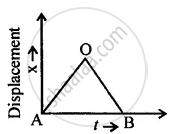Advertisements
Advertisements
प्रश्न
A train is moving with a velocity of 90 km h-1 . It is brought to stop by applying the brakes which produce a retardation of 0.5 ms-2 Find :
(i) The velocity after 10 s , and
(ii) the time taken by the train to come to rest .
उत्तर
Initial velocity u = 90 km/h = 25 m/s
Final velocity v = 0 m/s
Acceleration a = -0.5 m/s2
(i) Let 'V' be the velocity after time t = 10 s
Using the first equation of motion,
v = u + at
We get,
V = 25 + (-0.5) (10) m/s
V = 25 - 5 = 20 m/s-1
(ii) Let t' be the time taken by the train to come to rest.
Using the first equation of motion,
v = u + at
We get,
t' = [(0 - 25)/ (-0.5)] s
t' = 50 s
APPEARS IN
संबंधित प्रश्न
Bus X travels a distance of 360 km in 5 hours whereas bus Y travels a distance of 476 km in 7 hours. Which
bus travels faster ?
A motorcyclist drives from place A to B with a uniform speed of 30 km h-1 and returns from place B to A with a uniform speed of 20 km h-1. Find his average speed.
A car is moving on a straight road with uniform acceleration. The speed of the car varies with time as follows :
Time (s) : 0 2 4 6 8 10
Speed (m/s) : 4 8 12 16 20 24
Draw the speed-time graph by choosing a convenient scale. From this graph :

(1) Calculate the acceleration of the car.
(2) Calculate the distance travelled by the car in 10 seconds.
The speed of a moving object is determined to be 0.06 m/s. This speed is equal to :
What do you mean by motion in one direction?
Express the following in m s-1.
1 km h-1
A car is moving in a straight line with speed 18 km h-1. It is stopped in 5 s by applying the brakes. Find:
- the speed of car in m s-1
- the retardation and
- the speed of car after 2 s of applying the brakes.
For the motion with uniform velocity , how is the distance travelled related to the time ?
A speeding car changes its velocity from 108 kmh−1 to 36 kmh−1 in 4 s. Calculate its deceleration in
- ms−2
- kmh−2.
Write down the type of motion of a body along with the A – O – B of the following distance – time graph.

